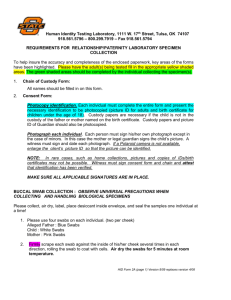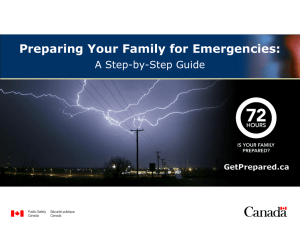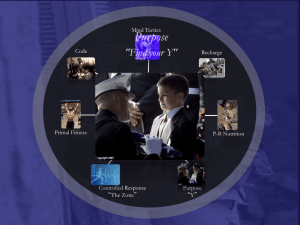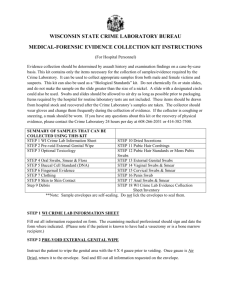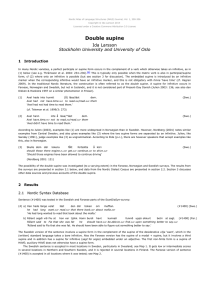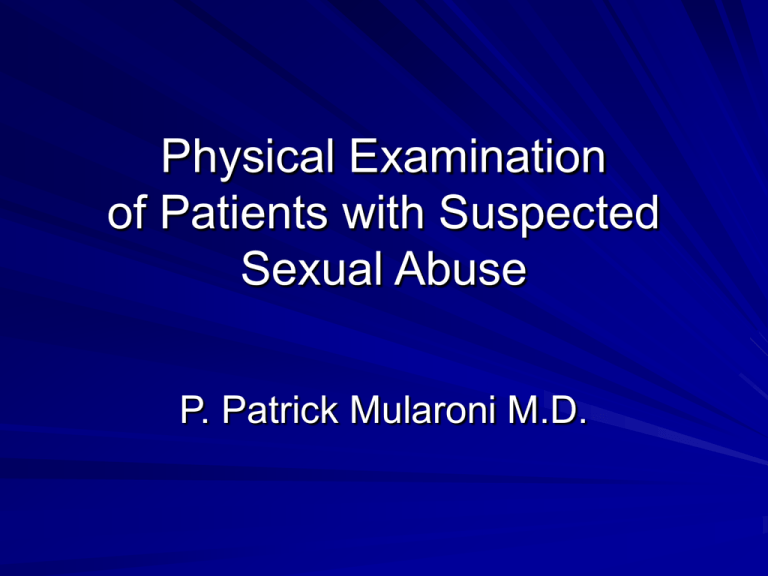
Physical Examination
of Patients with Suspected
Sexual Abuse
P. Patrick Mularoni M.D.
Medical Complaints
Genital, Urethral, or Anal Trauma
Bleeding or Discharge
Dysuria
Abdominal Pain
Headaches
Constipation or Encopresis
Foreign Bodies in the Vagina or Anus
Pregnancy
Behavioral Indicators
Temper Tantrums
Sleep Disturbance
Phobias
Self-Injury
Substance abuse
School problems
Who Should Be Examined in the E.D. ?
Individuals who report sexual abuse that
has occurred within the last 72 hours
should have a History and Physical Exam
performed as expeditiously as possible
Those individuals with a remote history of
abuse should be examined after a
disclosure interview is undertaken
Preparing for Examination
Patients should be triaged and placed in an
appropriate examination room
The Social Worker, Child Life Specialist, and
trained Nursing staff should be involved
History may be obtained from the adult who is
bringing the child to the Emergency Department
in a separate location
While the parent interview is occurring, the
patient can become familiar with the Child Life
Specialist and the exam room/ equipment
Preparation
Child Life Specialists use play and actual medical
equipment to:
Address concerns
Clarify misconceptions Communicate
expectations
Develop trust
Offer coping techniques
Provide familiarity of equipment and
environment
Reduce anxiety
Offer choices for feelings of control
Communicates pertinent information to the
provider
Focusing Techniques/Distraction
“Bubbles
“Viewmaster”
“I Spy” books
“Gameboy”
Headphones
Talking with patient
Initiation of Exam
The patient is introduced to the examiner
and a brief history is taken from the child
- use the patients terms for body parts
(privates, girl parts, pee, etc.)
- the patient should be reassured that
this is a “check up”
- use an unhurried approach and allow
the pt. to feel “in control”
Examination
Start with a familiar head to toe
examination
- noting: signs of puberty
signs of physical trauma
adenopathy
pharyngitis
Examination
Perform genital exam as the next step in a
head to toe evaluation
- emphasize that you are “taking a look”
- point out to the pt. that the colposcope
(otoscope) is not touching the pt.
Supine Frog Leg
Supine Separation Technique
Supine Separation Technique
In the supine
separation technique,
the labia are
separated with the
tips of the fingers in a
lateral and downward
movement
The vestibule and
Hymen should be
exposed
Supine Traction Technique
Supine Traction Technique
The Examiner grasps
the Labia Majora with
the thumb and index
finger and gently pulls
outward and slightly
upward
This technique helps
the examiner
visualize the edge of
the hymen more
easily
Prone Knee Chest
Knee-Chest Position
The child rests her
head on her folded
forearms
The examiner
presses a thumb
outward on the
leading edge of the
gluteus maximus
Supine Knee Chest
Cultures
Pt should be shown the soft cotton tip of
the swab
A decision of whether cultures should be
obtained should be made and discussed
with nursing staff prior to the exaimner
entering the room
Closing
If the exam is normal be sure to tell the
patient that they have a normal exam
If there are findings, reassure the patient
that these areas will heal quickly
Patients can also be reassured that when
healed, friends and even doctors will not
be able to see what has happened
Adolescent Female Exam
Adolescent patients should be approached
in the same way as prepubertal patients.
The exam and equipment should be
explained prior to the examination
beginning
Patients should be given reassurance and
a sense of control
Examination
There is debate as to whether a speculum
should be used in all examinations
Presently endocervical cultures for
N. gonorrhea and C. trachomatis are the
“gold standard”
PCR and LCR studies for ghonorrea and
chlamydia testing are ongoing
The Rape Kit
All clothing should be individually bagged
in a paper bag (not sealed plastic)
Underwear should be placed in the bag
provided
If there are visible blood or semen stains
moisten one of the enclosed gauze pads
and remove the stain. Allow the pad to air
dry and place it in one of the plastic bags
provided
Rape Kit
Vaginal or Cervical contact
Swab the Vagina to get as much fluid as
possible and wipe cotton swabs across the
slides marked VAGINAL SMEARS
Allow swabs to air dry and place them in
the envelope marked SWABS
Each envelope and container will be
marked with the victims name and what
type specimen is contained
Rape Kit
Anal or Rectal Contact
Moisten two cotton tipped swabs and
collect any secretions fro the buttocks and
perineal region
Swab the rectal area with 2 cotton tipped
applicators and place each in an envelope
Use one of the swabs from the rectum and
create a smear on one of the slides
provided
Rape Kit
Oral Contact
Use 2 swabs to swab the oral mucosa
Create a smear with the first applicator
Take the second smear and place it into
an envelope marked SWABS
Rape Kit
DNA Buccal Swabs
Use 2 swabs and rub vigorously along the
buccal mucosa and place both applicators
in an Envelope marked SWABS
Rape Kit
Secretions, Stains, or Forensic Materials on
the Body
Get a cotton tipped applicator wet and
soak against a suspicious bite mark or stain
Allow the applicator to air dry and place
the swabs in the Questioned Materials
envelope
If there is dried material, scrape the
“crusty” material into the plastic material
container in the Questioned Materials
envelope
Rape Kit
If history indicates that the assailant was
scratched sufficiently by the victim
Collect and visible tissue or blood stains
with tweezers and place them in the plastic
container in the Questioned Materials
envelope
Clip fingernails and place in a piece of
paper with a pharmaceutical fold and place
in the Questioned Material envelope
Rape Kit
Hair Samples (Reference)
Pluck or comb out 25 random hairs from
the victims head
Use a fine tooth comb to obtain 25 random
pubic hairs
Rape Kit
If there is matted pubic hair or hair with
possible human materials on them then
clip those hairs and Place in the Pubic
Combings envelope
Rape Kit
When you are finished collecting the
specimens you are to seal the Sexual
Assault Evidence Kit with the orange
sticker inside and sign the sticker.
You will also need to fill out the form on the
front of the envelope and assure that the
nurse that you are giving the evidence to
has done the same
Documentation
At Hughes Spaulding there is a separate
49 form which needs to be filled out
* ONLY UPPER LEVEL RESIDENTS
CAN DO A “49” EXAM !!!
At Egelston there is a sexual abuse
template that you should look at prior to
going into the room (it has many questions
that you may not think to ask)
Disposition
There should be a Social Work and
DFACS referral for all patients with and
Alleged Sexual Assault (ASA)
The social worker or DFACS will arrange
for follow up which may include a home
visit and a forensic interview

